|
16. Family traits
The butterfly fauna in the Benelux is represented by six families. There follows a description of the similarities and differences between the species contained in each family.
Skippers - Hesperiidae
Skippers are small butterflies known for their striking jerky flight. They have broad heads with big eyes. Most skippers are dull in colour, some are well camouflaged when they are basking on bare soil. Two subfamilies are known in the Benelux: Hesperiinae and Pyrginae, each contain 7 species.
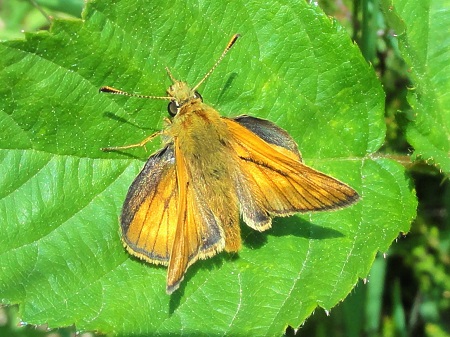 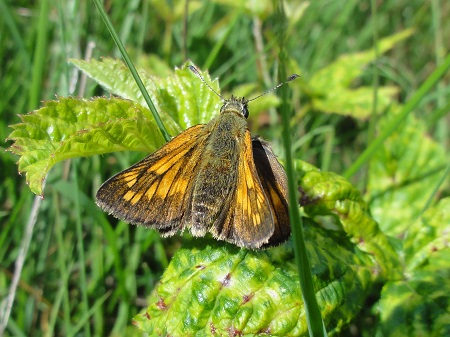
Ochlodes sylvanus.
Photographs: Rosita Moenen ©.
The larvae of the Hesperiinae feed on grasses, those of the Pyrginae feed on herbs. The male butterflies have special scent organs associated with courtship; depending on the species, plumes on the legs, a fold along the front of the forewings or a furrow with androconia (scent scales) in the centre of the forewings. The large chequered skipper (Heteropterus morpheus) is an exception, not having a scent organ but has a remarkably coloured underside of the hind wing that is shown at flight.
The larvae of skippers have simple prolegs, they cannot get a good grip on the host-plants and therefore they usually live inside a folded leaf; the larvae catapult their droppings far away. Those of the silver-spotted skipper (Hesperia comma), however, live in a tent constructed in a clump of a fine-leaved grass.
Most skippers occur in long lasting populations, except the mallow skipper (Carcharodus alceae), which is a nomad and wanders, sometimes large distances.
Skippers have no defence mechanisms against predators thus concealment and camouflage are the only possibilities to evade their enemies.
Table 16-1. Characteristics of the family of the Hesperiidae.
| |
Skippers (grass eaters) |
Skippers (herb eaters) |
subfamily |
Hesperiinae |
Pyrginae |
| Behaviour over time |
overwinters as larva or egg |
overwinters as larva or pupa |
| Behaviour in space |
stay-at-home |
stay-at-home or nomad |
| Defence against threats |
hiding |
hiding |
| Search for food |
grass and nectar |
herbs and nectar |
Swallowtails - Papilionidae
Swallowtails are relatively large butterflies, bright in colour and with a stately manner of flying. This family has three represents in the Benelux of which the swallowtail (Papilio machaon) is the only species that occurs throughout the region and even the numbers of this species fluctuate widely. In the south of Belgium it is present every year, in the Netherlands it may be absent in periods of some successive poor summers. In Luxemburg and south Wallonia the scarce swallowtail (Iphiclides podalirius) is present and also, as a very rare vagrant, the Apollo (Parnassius apollo) the nearest population of which occurs in the valley of the Mosel in Germany near Cochem, about 40 kilometres from the Luxemburg border. The latter is a member of the subfamily Parnassiinae, the other two of Papilioninae.
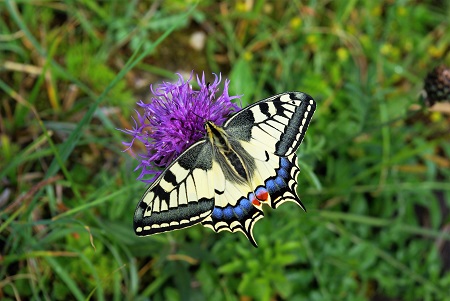 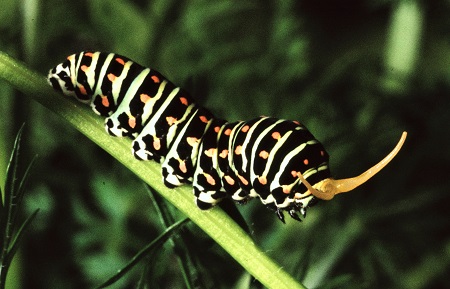
Papilio machaon.
Photographs: Frits Bink ©.w
The larvae of the swallowtails have a striking defence organ, the osmeterium, hidden in the neck that can suddenly be pushed out in the case of danger. The larvae have cryptic or aposematic colours, in the early stages they mimic a bird dropping. The larvae of the Apollo are black with bright orange and blue spots. These larvae are poor climbers but fast runners on the rocky soil. A stony soil is also useful for the larvae to have places both for warming up and keeping cool in the heat of the day.
The larvae of all species feed on host-plants containing some defence chemicals, which are distasteful to predators.
Table 16-2. Characteristics of the family of the Papilionidae.
| |
Apollo |
Swallowtails |
subfamily |
Parnassiinae |
Papilioninae |
| Behaviour over time |
overwinters as egg |
overwinters as pupa |
| Behaviour in space |
stay-at-home |
nomad |
| Defence against threats |
larva has osmeterium, aposematic colours |
larva has osmeterium, mimetic, camouflage, aposematic colours |
| Search for food |
stonecrop (Sedum) and nectar |
herbs (Apiaceae), shrubs (Prunus), nectar |
Whites and yellows - Pieridae
The family of the Pieridae is represented in the Benelux by three subfamilies: Dismorphinae, wood whites (1 species), Pierinae, whites (6 species) and Coliadinae, yellows (5 species).
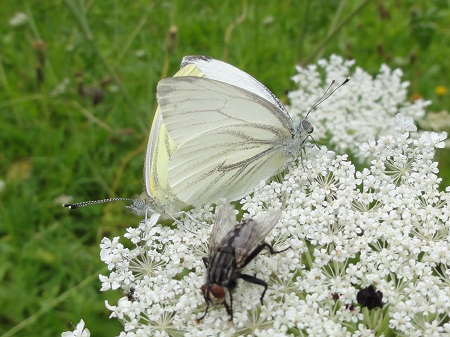 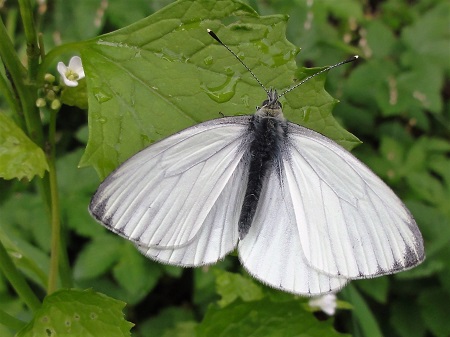
Copula Pieris napi.wwwwwwwwwwww w wwwwwww w wwwww wxxxwwwwww xw xMale Pieris napi.
Phogtograph: Frits Bink ©.w w wwwwww w wwwwww w wwwwww w wwwwwww w Photograph: Rosita Moenen ©.
The whites vary in size, one of the biggest is the large white (Pieris brassicae), the small white (Pieris rapae) is average sized and the smallest one is the wood white (Leptidea sinapis). The small white is our most common and most widely distributed butterfly.
The yellows are irregular in occurrence and they are most seen on arable fields with lucerne (Medicago sativa) or red clover (Trifolium pratense). The largest of the yellows is the brimstone (Gonepteryx rhamni), the only species in this family that hibernates as adult and can live up to a year.
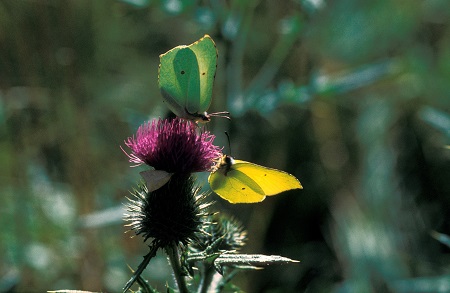 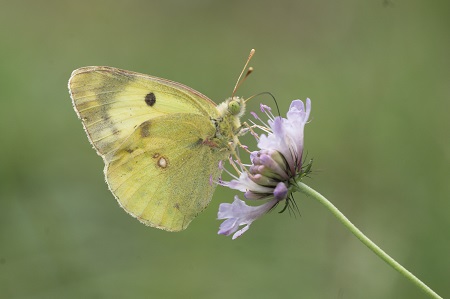 Gonepteryx rhamni.wwwwwwwwwwww w wwwwwww w wwwww wxxxwwwwww xwColias hyale. Gonepteryx rhamni.wwwwwwwwwwww w wwwwwww w wwwww wxxxwwwwww xwColias hyale.
Phogtograph: Frits Bink ©.w w wwwwww w wwwwww w wwwwww w wwwwwww w Photograph: Jeroen Voogd ©.
All species are herb-eaters, except the brimstone and the black-veined white (Aporia crataegi) of which the larvae feed on shrubs.
The butterflies of this family are usually safe from bird predation. The species that feed in the larval stage on crucifers (Brassicaceae) acquire some of the defence chemicals of the plants and this makes them poisonous or distasteful. All the white coloured butterflies resembles each other. They profit from this resemblance since predators after tasted one will avoid them all, Müllerian mimicry. The adults have a repellent, the chemical substance pterine in their wing scales.
Table 16-3. Characteristics of the family of the Pieridae.
| |
Wood whites |
Whites |
Yellows |
subfamily |
Dismorphinae |
Pierinae |
Coliadinae |
| Behaviour over time |
overwinters as pupa |
overwinters as pupa |
overwinters as larva |
| Behaviour in space |
stay-at-home |
nomad |
stay-at-home, migrant |
| Defence against threats |
resembles whites |
nasty taste |
nasty taste |
| Search for food |
leaf-eater, clover, vetch, pea, nectar |
leaf-eater, crucifers, nectar |
leaf-eater, clover and nectar |
Duke of Burgundy fritillary - Riodinidae
Riodinidae occur worldwide but it is only in the tropics of South-America where there are many small, brightly coloured species which are called the metal marks. This family is related to Lycaenidae and myrmecophily occurs in many species. In Europe this family has only one representative, Hamearis lucina, which looks like a small fritillary.
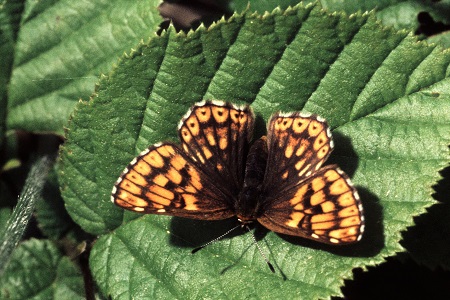
Hamearis lucina.
Photograph: Frits Bink ©.
It has no organs for ant-appeasing, nevertheless it lives in places where ants are abundant and active. In the Benelux it occurs in the south of Wallonia and in Luxemburg. It lives in the brushwood of hazel (Corylus avellana) on the gradient of chalk grassland into woodland.
Table 16-4. Characteristics of the Duke of Burgundy fritillary.
family |
|
subfamily |
Nemeobiinae |
species |
Hamearis lucina |
| Behaviour over time |
overwinters as pupa |
| Behaviour in space |
stay-at-home, territorial |
| Defence against threats |
hiding |
| Search for food |
leaf-eater, nectar |
Blues, coppers and hairstreaks
The family Lycaenidae is represented in the Benelux by three subfamilies: Polyommatinae, blues (23 species), Lycaeninae, coppers (6 species) and Theclinae, hairstreaks (8 species).
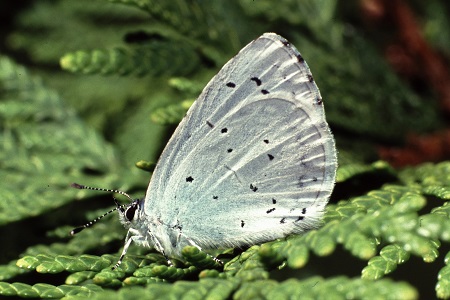 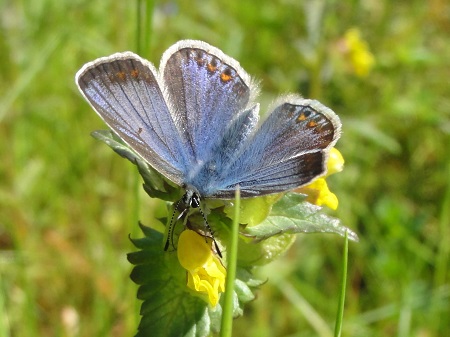
Celastrina argiolus.wwwwwwwwwwww w wwwwwww w wwwww wxxxwwwwww xw Polyommatus icarus.
Phogtograph: Frits Bink ©.w w wwwwww w wwwwww w wwwwww w wwwwwww w Photograph: Rosita Moenen ©.
The males of the blues often have blue wings but the females’ are usually brown, both males and females of the coppers are usually orange and those of the hairstreaks dull brown on the uppersides but the undersides are beautifully decorated. In general the females of the hairstreaks are more brightly coloured than males and also have hindwings with an outward curled anal angel with a bright coloured spot, seen from behind as a mirror (speculum). It seems that these females are dominant in courtship. Most hairstreaks overwinter in the egg stage and feed on shrubs or trees, the exception is the green hairstreak (Callophrys rubi) that overwinters as pupa in the leaf litter.
The members of the Lycaenidae family have a remarkable habit, they collaborate with the enemy, predacious ants. The larvae have special organs to appease predatory ants: over the whole body a large number of micro-tubercles that can produce a scent, in the centre of the 7th abdominal segment an organ that produces a sweet liquid when the larva is attended by ants and on both sides of the 8th segment a tentacle that is pushed out as an encouragement for the ant to remain. In most species the pupae can stridulate, especially in species which pupate in the litter layer.
The species with an obligate myrmecophily lifestyle, the Maculinea species are famous. During the first three stages the larvae feed in flower heads, then the larvae leave their host plant and are adopted by ants of the genus Myrmica. Some live as a kleptoparasite, others as a real predator in the ants nest.
Table 16-5. Characteristics of the family of the Lycaenidae.
| |
blues |
coppers |
hairstreaks |
subfamily |
Polyommatinae |
Lycaeninae |
Theclinae |
| Behaviour over time |
overwinters as larva |
overwinters as larva |
overwinters as egg |
| Behaviour in space |
stay-at-home, nomad |
stay-at-home, scouting |
stay-at-home |
| Defence against threats |
myrmecophily, weak to obligate |
myrmecophily very weak |
myrmecophily weak |
| Search for food |
bud, fruit, leaf-eaters and nectar, some also dung |
leaf-eater, sorrel and docks and nectar |
bud and sprout-eater,
honeydew and nectar |
Brush-footed butterflies
The species of this large butterfly family exhibit a great variety in size, there are as well small as very large ones: wing lengths vary from 16 up to 44 mm. Most adults are dull brownish in colour but a few are brightly coloured. The characteristic of all species of this family is the possession of brush feet, the two front legs are modified to a cleaning paw, unsuitable for walking.
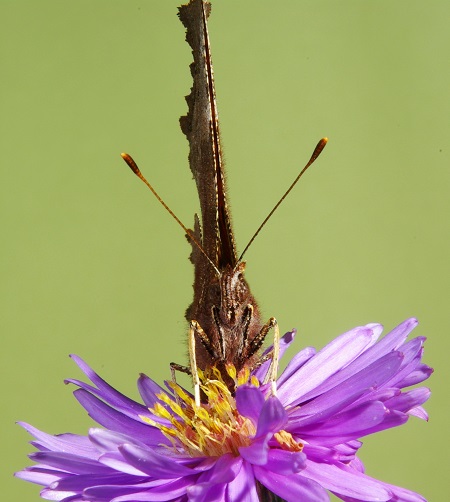 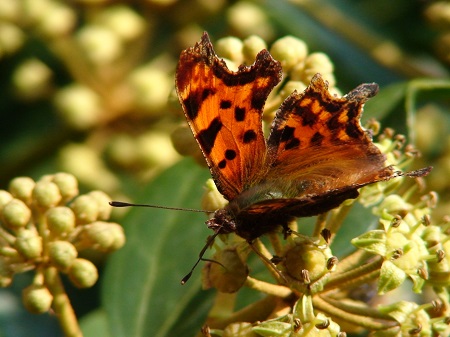
Polygonia c-album.
Photograph: Frits Bink ©.w
Most species are remarkable in that the pupa is free hanging, attached only by the point of the abdomen (cremaster) to a small silk pad spun by the larva. Among the browns there are some species of which pupate underground in a chamber.
In the Benelux this family is represented by six subfamilies: Satyrinae (20 species), Apaturinae (2 species), Limenitidinae (2 species), Nymphalinae (8 species), Melitaeini (8 species), Heliconiinae (12 species).
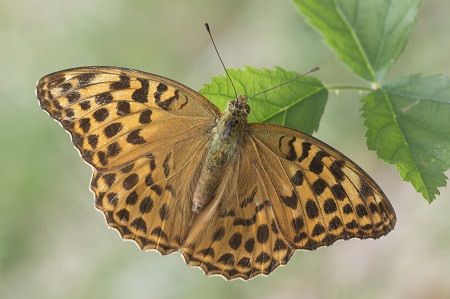 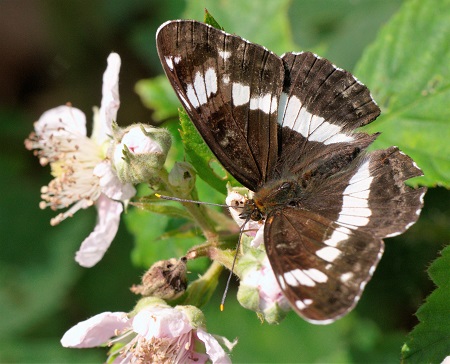
Argynnis paphia.wwwwwww w wwwwwww w wwwww wxxxwwwwww xw ww ww wx Limenitis camilla.
Photograph: Jeroen Voogd ©.wwwwwww w wwwwwwwwww w wwwwwww w ww w Photograph: Jeroen Voogd ©.w w wwwww wxxxwwwwww xw ww w w
The subfamily Satyrinae has larvae which eat grasses, making the subfamily quite different from an ecological point of view. Grass is a poor food source, with a low protein content. The larvae are slow growing and there are only four species which are able to produce two broods per year. In most species the lifecycle is synchronized to the growing cycle of the grass, in such way that the food demand is the highest when the grass has its highest content of protein. However, some larvae in their last instar are able to feed on grass that is already yellow and withered, their protein demand being very low they utilise the cellulose for the development of fat-bodies.
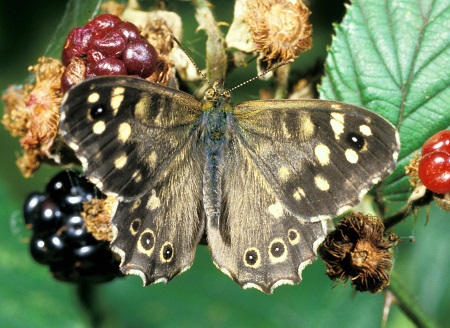 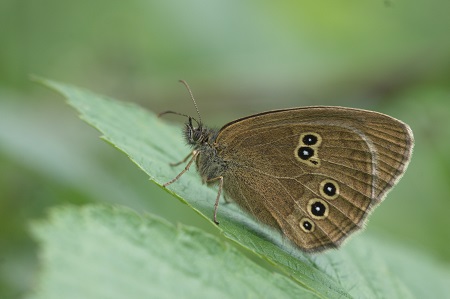
Pararge aegeria. wwwwww w wwwwwwwwww w wwwwwww w ww w wwwwww w wAphantopus hyperantus
Photograph: Frits Bink ©. wwwwww w wwwwwwwwww w wwwwwww w ww wwwwwPhotograph: Jeroen Voogd ©.
Some species of the other subfamilies have highly evolved remarkable mechanisms for defence against predators by misleading and in their exploration of the landscape. The subfamily Nymphalinae is famous by its beautifully coloured butterflies which hibernate.
Table 16-6. Characteristics of the family of the Nymphalidae.
| |
browns |
emperors |
admirals |
tortoiseshells |
plantain-fritillaries |
violet-fritillaries |
subfamily |
Satyrinae |
Apaturinae |
Limenitidinae |
Nymphalinae |
Melitaeini |
Heliconiinae |
| Behaviour over time |
overwinters as larva |
overwinters as
young larva |
overwinters as young larva in hibernaculum |
overwinters as adult |
overwinters as larva in silky web |
overwinters as larva
or egg in litter-layer |
| Behaviour in space |
stay-at-home |
stay-at-home and scouts |
stay-at-home and scouts |
nomad or migrant |
stay-at-home |
stay-at-home, nomad |
| Defence against threats |
concealment camouflage |
camouflage in larval
and pupal stage |
misleading appearance in larva and pupa |
nasty taste, larva
with spines |
nasty taste, larva
with bristles |
nasty taste, larva
with spines |
| Search for food |
grass-eaters, nectar |
leaf-eaters, dung
and mud |
leaf-eaters, dung and mud |
herb-eaters, nectar, fruit |
herb-eaters, nectar |
violet-eaters, nectar |
|


















